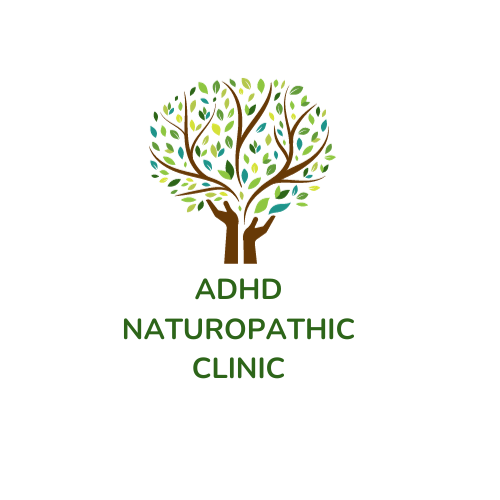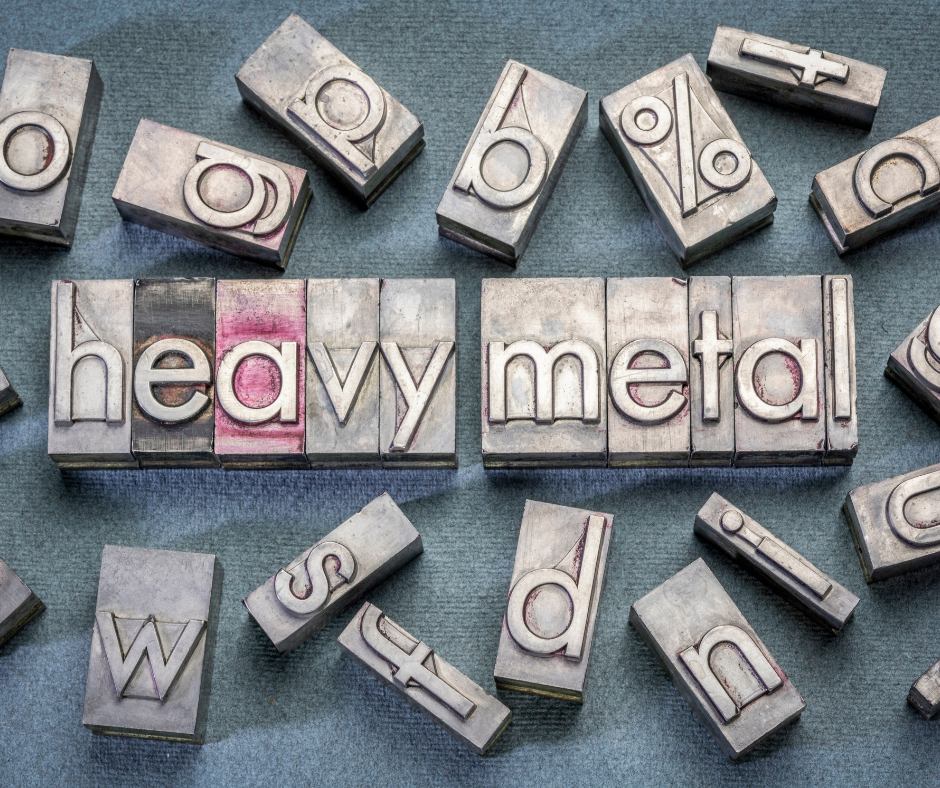When we think about conditions like ADHD, anxiety, autoimmune illness, or chronic fatigue, we often look to lifestyle, stress, or inherited genetics. Those matter—but there’s another influence that’s easy to miss: toxic metals (e.g., lead, mercury, cadmium, arsenic, aluminium, and others). These metals enter the body through everyday routes—food and water, air pollution, dental materials, cosmetics, cookware, and some household or occupational exposures.
Once inside, they don’t clear quickly. Many bioaccumulate in tissues such as bone, brain, liver, and kidneys. They can displace essential minerals (e.g., lead for calcium; cadmium for zinc), bind to enzymes and block their function, increase oxidative stress, and impair mitochondria (the cell’s energy systems). In the nervous system, they may alter neurotransmitter synthesis and signalling; in the immune system, they can skew inflammatory responses. Because some metals have long biological half-lives (for example, lead in bone and cadmium in kidney), the body’s toxic load can persist for decades.
Importantly, metals can cross the placenta and are detectable in breast milk, meaning exposures from a parent’s past can contribute to a child’s body burden. Lead stored in maternal bone, for instance, can be mobilised during pregnancy and lactation. This helps explain why today’s children may carry a portion of their grandparents’ exposures, layered on top of modern sources.
The takeaway: persistent metal exposures can subtly influence brain development, immune regulation, energy production, and hormonal balance. For some people, this background burden becomes a meaningful contributor to symptoms. Recognising and measuring it is a critical first step in a root-cause approach—one reason tools like HTMA (to map mineral patterns alongside potential toxic elements) are so useful in guiding targeted support.
Heavy Metals: Hidden and Stored for Decades
Heavy metals such as lead, mercury, aluminium, cadmium, and arsenic don’t simply leave the body once exposure ends. Unlike essential minerals, which are regularly used and excreted, toxic metals have a strong tendency to bind to proteins, enzymes, and structural tissues. This binding makes them far harder to remove naturally, and as a result, they often become sequestered in long-term storage sites such as bone, brain tissue, liver, kidneys, and fat cells.
Because of this persistence, exposures that occurred decades ago can still have a measurable impact today. For instance, lead has a biological half-life of about 20–30 years in bone. During times of stress, pregnancy, or aging-related bone turnover, that stored lead can be remobilised into the bloodstream, creating new toxicity even without fresh exposure. Mercury, especially in its methylmercury form, tends to accumulate in the brain and fatty tissues, where it can disrupt neurotransmitter balance and mitochondrial function for years. Cadmium has an estimated half-life of 10–30 years in kidney tissue, gradually impairing detoxification and mineral balance.
Everyday sources, once thought to be “harmless,” have played a big role in this accumulation. People exposed to lead plumbing, mercury-based dental fillings, or aluminium cookware decades ago may still carry significant body burdens. Even if the exposure has stopped, the stored metals can continue to interfere with biochemical pathways, displace essential minerals like zinc or magnesium, and promote oxidative stress.
This is why a person’s present-day symptoms — whether brain fog, fatigue, mood changes, or difficulty focusing — can sometimes be traced back to past exposures that remain locked within the body’s tissues. Identifying these hidden toxic loads is a critical part of understanding the bigger picture of health.
How Heavy Metals Enter the Body
In addition to well-known sources like contaminated water, dental fillings, and old cookware, heavy metals can enter the body through many everyday products. For example, cosmetics, skincare, and personal care items may contain trace amounts of metals such as lead, aluminium, and cadmium, either as contaminants or as part of pigments and preservatives. Similarly, laundry detergents, household cleaners, and even processed foods can introduce small amounts of toxic metals that accumulate over time. Airborne exposure is another often-overlooked route: urban pollution, vehicle emissions, and industrial fumes can deposit metals like lead and cadmium on skin, hair, or in dust that is inhaled. Even low-level, repeated exposures from these sources can contribute to a gradual body burden, subtly affecting nervous system function, immune regulation, and overall biochemical balance.

Children are particularly vulnerable because they often play close to the ground, put objects in their mouths, and explore their environment with their hands. Some common but overlooked sources include arsenic-treated pine logs in older playgrounds, where climbing and touching the wood can lead to absorption of toxic metals. Similarly, plastics in toys may contain trace metals, and mouthing these objects provides a direct route into the body. Environmental chemicals also contribute; for example, some local councils have historically sprayed glyphosate and other herbicides on park lawns, which children then come into contact with while playing.

Certain professions carry a higher risk of heavy metal exposure due to frequent contact with metals or contaminated materials. People working in battery manufacturing, welding, mining, smelting, painting, or industrial machinery may encounter lead, cadmium, or mercury on a daily basis. Dental professionals, electricians, and workers in electronics or recycling industries can also be exposed over time. Even seemingly low-level occupational exposure can contribute to cumulative body burden, particularly when combined with metals absorbed from environmental and household sources. Awareness of these risks is important for preventive strategies and testing, especially for those experiencing unexplained neurological, immune, or metabolic symptoms.
Passed Down Through Generations
What makes heavy metal exposure particularly concerning is that these toxins don’t remain isolated to the individual—they can be passed down from one generation to the next. During pregnancy, metals stored in maternal tissues, such as lead in bone or mercury in fat, can cross the placenta, exposing the developing fetus. After birth, some metals are also present in breastmilk, meaning that newborns can inherit a portion of their mother’s accumulated toxic burden.
This process creates a layered, generational load of heavy metals. For example, a child today may carry metals their grandparents were exposed to decades ago, combined with their own exposures from the modern environment. This cumulative burden can interfere with neurological development, immune function, hormone regulation, and cellular energy production, even before a child has experienced significant environmental exposures themselves.
The implications are broad: this inherited toxic load helps explain why conditions such as ADHD, autism spectrum disorders, learning difficulties, autoimmune diseases, chronic fatigue, and mood disorders are increasingly prevalent. Children’s developing systems may already be partially compromised at birth, making them more sensitive to additional environmental stresses and highlighting the importance of early detection and prevention.
How HTMA Can Help
So how do we uncover these hidden toxic patterns and mineral imbalances? One of the most effective tools is Hair Tissue Mineral Analysis (HTMA). This simple, non-invasive test examines a small sample of hair, which reflects the levels of both essential minerals and toxic metals stored in the body over the previous two to three months.
Unlike blood tests, which capture only what is currently circulating, HTMA provides a more comprehensive view of the body’s longer-term biochemical patterns. Because hair grows slowly, it acts like a “record” of what your body has been holding onto, including heavy metals that may have accumulated over decades.
This information allows us to connect the dots between symptoms and underlying toxic burdens or mineral imbalances. For example, a child with hyperactivity, poor focus, or mood swings may show elevated copper, low zinc, or cadmium accumulation, while adults experiencing chronic fatigue, brain fog, or weakened immunity may have other mineral disruptions or hidden toxic loads. HTMA results not only help identify what’s out of balance, but also guide personalized interventions to support detoxification, restore mineral balance, and improve overall health outcomes.
By using HTMA, we can move beyond symptom management and begin to address the root causes, giving both children and adults a clearer pathway to optimal health.
Why This Series Matters
Over the next few weeks, I’ll be sharing a blog series on Heavy Metal Toxicity, diving deep into specific metals such as lead, mercury, aluminium, cadmium, and arsenic. We’ll explore how these metals can affect not just ADHD, but also brain health, hormone balance, energy production, immune function, and overall wellbeing. Each post will break down the science in an easy-to-understand way, helping you see the connection between hidden toxic burdens and common health challenges.
By following the series, you’ll gain insight into how heavy metals accumulate in the body, how they can be passed across generations, and why early detection is so important. We’ll also look at practical tools, like HTMA, that reveal underlying imbalances and guide personalized strategies for detoxification and restoring mineral balance.
👉 Don’t miss a post — sign up to my newsletter to have each article delivered straight to your inbox.
Together, this series will shine a light on how hidden toxins may be quietly influencing your health, and provide actionable information on how functional medicine can help uncover the root causes and support long-term wellness.
Ready to find answers?
At the ADHD Naturopathic Clinic, we use HTMA to uncover the hidden imbalances behind ADHD symptoms and Chronic health issues. Book your consultation today and take the first step towards lasting health. Book Your Initial Consultation now.
Disclaimer:
The information provided in this blog is for educational and informational purposes only and is not intended to replace individual medical advice, diagnosis, or treatment. Always consult with a qualified healthcare professional or your GP before starting any new health program, herbal supplement, or treatment—especially if you are pregnant, breastfeeding, taking medication, or have an existing medical condition. The content shared by Oak Tree Herbal Clinic is based on traditional and clinical herbal knowledge and is not intended to diagnose, treat, cure, or prevent any disease. Individual results may vary.

